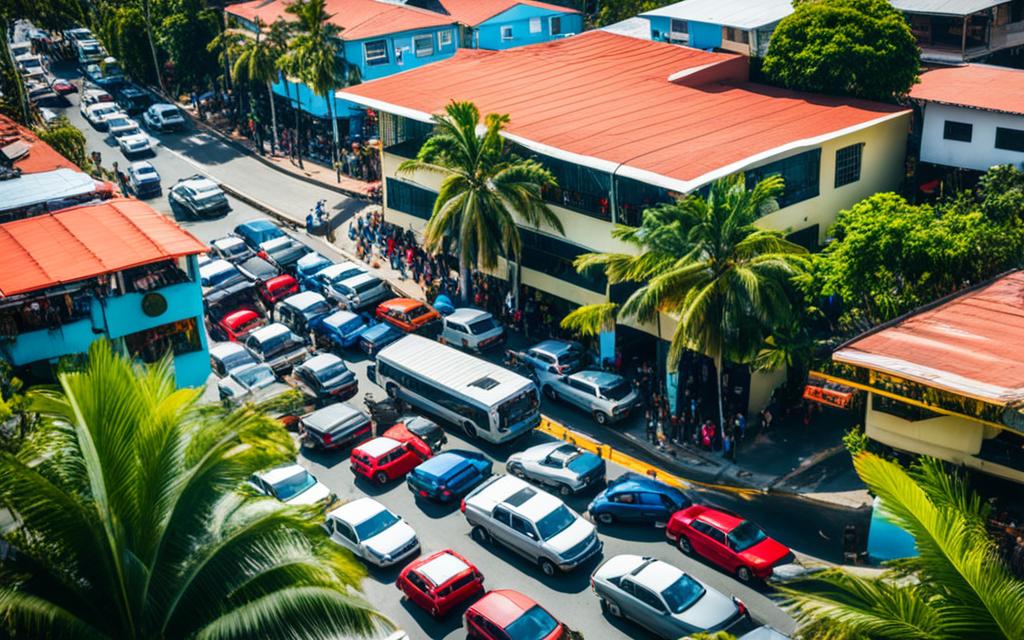Traffic congestion in Costa Rica is a major concern for both residents and commuters. While factors such as construction work, lack of planning, and limited public transportation options contribute to the problem, daily minor crashes also play a significant role in worsening the traffic situation.
According to statistics provided by the Traffic Police, between 100 and 150 minor traffic accidents occur across the country on a daily basis. These accidents result in material damage but usually do not cause any injuries. Rear-end collisions are a common occurrence, often happening when drivers are stuck in traffic.
Efforts are being made by the traffic police to respond to these incidents as quickly as possible in order to minimize further delays. However, it is essential for drivers to understand the importance of driving courteously and patiently to prevent such accidents which are largely preventable.
Key Takeaways:
- Traffic congestion in Costa Rica is worsened by daily minor crashes.
- Between 100 and 150 minor traffic accidents occur in the country each day.
- Rear-end collisions are common, often happening in heavy traffic situations.
- Drivers need to be patient and display courteous behavior on the roads.
- Preventing minor collisions can help reduce road congestion in Costa Rica.
Impact of “Law of the Strongest” Behavior on Traffic
In Costa Rica, a concerning behavior known as the “law of the strongest” prevails on the roads. Many drivers exhibit aggressive driving tendencies and attempt to forcefully navigate through traffic in order to gain an advantage, ultimately leading to an increase in traffic accidents.
The authorities emphasize the importance of courtesy and patience on the road as key factors in preventing such incidents. It is crucial for drivers to understand that these accidents are largely preventable if everyone on the road follows the rules and respects each other.
An important step towards reducing these incidents is that insurance companies have introduced an alternative method of resolving collisions without injuries, expediting the process and making it more efficient.
“Traffic accidents caused by aggressive driving can be avoided if drivers prioritize courtesy and patience on the road.”
To address these challenges, the traffic police have increased their presence on the route between Los Hatillos and Route 27. This increase in monitoring aims to address the issue of drivers disregarding channeling islands, which often leads to congestion and additional traffic problems.
By actively enforcing traffic laws and monitoring key areas prone to aggressive driving, the presence of traffic police can significantly reduce congestion and promote safer driving practices, ultimately leading to a decrease in preventable accidents.

Comparative Analysis of Traffic Accidents
| Year | Total Traffic Accidents | Accidents Caused by Aggressive Driving | Preventable Accidents |
|---|---|---|---|
| 2018 | 3,500 | 800 | 650 |
| 2019 | 3,200 | 900 | 600 |
| 2020 | 2,800 | 1,000 | 550 |
Efforts to Manage Traffic Congestion in Costa Rica
In an effort to effectively manage traffic congestion in Costa Rica, the Ministry of Public Works and Transport (MOPT) has implemented several strategic measures. One of the key initiatives employed is the use of aerial surveillance, which is provided by the Ministry of Security, to monitor the various roads in the capital. This innovative approach enables authorities to identify areas with high congestion and allows for targeted interventions to alleviate traffic issues.
The MOPT has specifically focused its efforts on monitoring critical points such as Circunvalación and the surrounding areas of Juan Pablo II, which are known to experience heavy traffic flow. By actively monitoring these areas during peak hours, both in the morning and afternoon, authorities aim to gain valuable insights into traffic patterns and congestion hotspots. This proactive approach empowers them to implement appropriate measures to reduce congestion and improve the overall traffic situation in Costa Rica.

Benefits of Aerial Surveillance for Traffic Management
The use of aerial surveillance provides several benefits for effective traffic management:
- Real-time monitoring: Aerial surveillance allows for real-time monitoring of traffic conditions, providing up-to-date information on congestion levels and traffic flow.
- Rapid response: By promptly identifying areas with high congestion, authorities can quickly deploy resources, such as traffic police, to manage the situation and keep traffic moving.
- Targeted interventions: With the insights gained from aerial surveillance, authorities can implement targeted interventions, such as adjusting signal timings, diverting traffic, or improving infrastructure, to reduce congestion in specific areas.
- Data-driven decision making: The data collected through aerial surveillance helps authorities make informed decisions regarding traffic management strategies, ensuring resources are allocated efficiently to areas that require the most attention.
Collaboration and Future Outlook
The efforts to manage traffic congestion in Costa Rica involve collaboration between the MOPT, Ministry of Security, and other relevant stakeholders. By leveraging advanced technologies such as aerial surveillance, the goal is to not only reduce congestion but also enhance road safety and improve the overall commuting experience for both residents and visitors.
Looking ahead, the implementation of data-driven solutions, along with ongoing monitoring and regular evaluation of traffic patterns, will continue to play a crucial role in managing traffic congestion in Costa Rica. Through collaborative efforts and the innovative use of technology, the aim is to create a more efficient and sustainable traffic management system that benefits everyone on the roads.
Conclusion
In conclusion, Costa Rica’s traffic situation is influenced by various factors, including daily minor crashes and the prevalent “law of the strongest” behavior. To address these challenges and improve road conditions, authorities are emphasizing the importance of courteous and patient driving, as well as enforcing traffic laws. By increasing the presence of traffic police on key routes and utilizing aerial surveillance to monitor traffic conditions, efforts are being made to reduce congestion and promote safer driving practices.
It is vital for drivers to be aware of these issues and take necessary precautions to ensure their own safety and the smooth flow of traffic. Along with following traffic regulations, adopting defensive driving techniques can significantly enhance safety on the roads. Simple driving tips such as maintaining a safe distance from the vehicle ahead, using turn signals, and obeying speed limits can greatly contribute to reducing the number of accidents and mitigating traffic congestion.
In addition, drivers should always stay alert, avoiding distractions such as mobile phone usage while driving. Prioritizing safety over impatience can help prevent unnecessary collisions and contribute to an overall improved traffic situation. By promoting a culture of responsible driving, everyone can play a part in creating a safer and more efficient road environment in Costa Rica.



